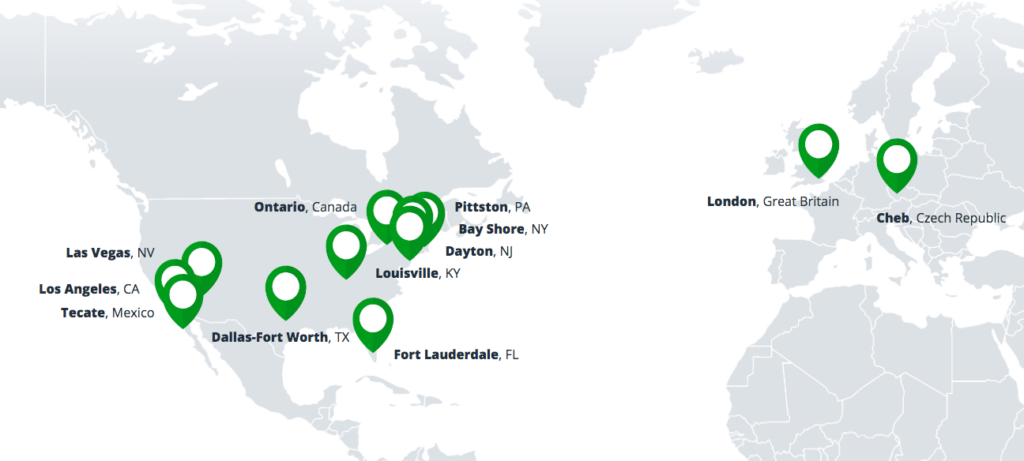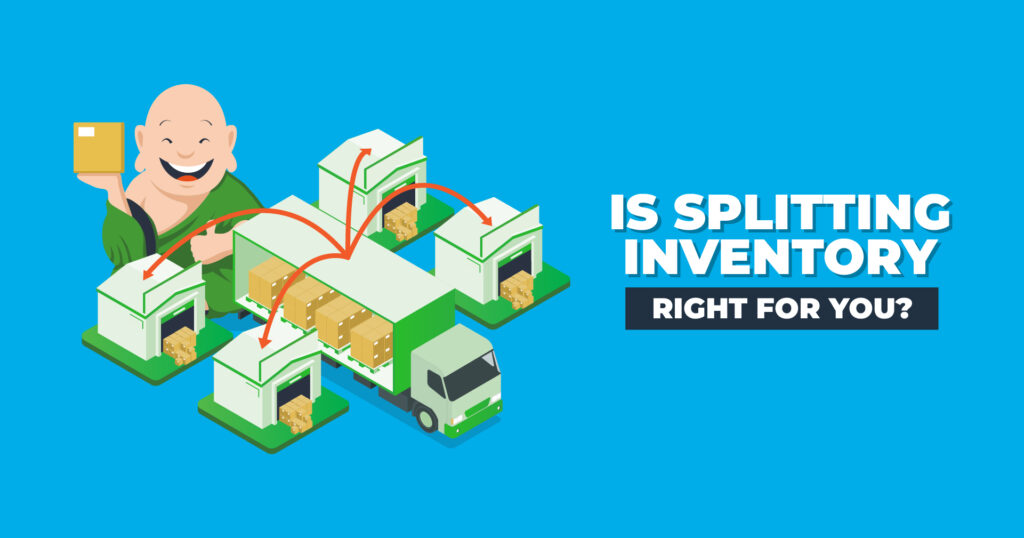What do we mean by distributed inventory? Well, if you’re familiar with Amazon’s practice of adding warehouses all over the country, then you’re familiar with the concept of distributed inventory. Splitting inventory across multiple warehouses used to be something that only huge retailers like Amazon could afford. As a result, small ecommerce businesses paid dearly to tap into those resources. Now, thanks to 3PLs like ShipMonk, smaller ecommerce merchants can take advantage of this inventory distribution strategy to decrease order shipping times and reduce shipping costs.
Today we’re going to cover what distributed inventory means, what it can do for your ecommerce business, and whether or not it’s right for you.

What is Distributed Inventory?
Distributed inventory, or split inventory, is the practice of storing inventory and running fulfillment operations from multiple fulfillment centers in different geographic locations. Think of it as setting up a hub-and-spoke model for ecommerce fulfillment, rather than fulfilling orders from a single, centralized location.
Large companies like Amazon and Walmart own and manage their own fulfillment centers. Third-party logistics (3PL) companies operate their own fulfillment centers, relieving their ecommerce clients of the upfront costs of building their own network. In addition, those lucky ecommerce clients can tap into the 3PLs wealth of expertise, technology, warehouse automation, and negotiated shipping rates. Of course, you can manage your own warehouses and fulfillment, but the upfront costs make it a steep climb.

How Do Orders Get Processed?
When all inventory is stored in a single fulfillment center, customer orders are transmitted from the online shopping cart to the fulfillment center, where they are picked, packed and shipped for delivery to the customer. When inventory is split among several warehouses, an order management system automatically determines which fulfillment centers have all the items in stock, and which of those can ship the order at the lowest cost. Orders are transmitted, picked and packed at the same speed, but strategically located fulfillment centers lead to faster shipping.

Why Would an Ecommerce Business Split Inventory?
There are several benefits to distributing some or all of your inventory across multiple warehouses.
Faster Shipping. By moving inventory closer to your customers, you can offer them faster shipping times. Large 3PLs like ShipMonk can reach 96% of the US population with 2-day shipping. And with fulfillment centers in Canada, Mexico, UK, and Europe, they can facilitate smooth international shipping, as well.
Lower Shipping Costs. Shorter distances and use of local or regional shipping carriers usually translate to lower shipping costs. If your company sells heavy goods, you’ll see even bigger savings.
Built-in Backup. If one warehouse unexpectedly runs out of your bestselling shoe color, another warehouse might be able to fill orders in the meantime. That’s a lot faster than waiting for a reorder, and a much nicer customer experience than seeing the item is backordered.
Increased Fulfillment Capacity. During peak sales periods, orders can be distributed over multiple warehouses so that no single warehouse gets overwhelmed.
Reduced Cost of Returns. Similar to routing orders to the nearest facility, returns can also be sent to the nearest facility, thereby reducing shipping costs and time for you and your customer.
Easier to Penetrate New Markets. Let’s say your business originated in California, but you’re planning a big push into east coast markets. Partnering with a 3PL that already has fulfillment centers out east makes it oh-so-easy. And you can take advantage of regional and local carriers to save on shipping.
Cross-border Solutions. Shipping across national borders can be slow, costly, and complex. An offshore or near-shore fulfillment center can handle the sticky issues like customs, duties, and taxes for you.

Are There Disadvantages to Splitting Inventory?
Despite all the advantages, there are a few disadvantages to splitting inventory.
More Complex Inventory Management. You’ll need to have the systems in place to ensure that you’re not carrying too much or too little inventory in each location. The system should centralize order and inventory management, so you have access to data from all locations in one place. Otherwise it’s like herding cats. ShipMonk’s robust, fully-integrated order, inventory, and warehouse management system makes this easier.
Additional Costs. If you’re building or leasing this additional fulfillment center on your own, your overhead costs can increase significantly. Even when using a 3PL with an existing network, you’ll need to ship inventory to multiple locations, which will increase your inbound freight costs. There may also be set-up costs at the new location. Either way, you’ll need to make sure the savings you’ll gain by splitting inventory will outweigh the costs.
When Does Inventory Distribution Make Sense?
This all sounds great, but does splitting inventory make sense for every ecommerce business? The short answer is no, but there are a few telltale signs that it might be right for yours.
- Your customers are widespread geographically, and/or you’re selling internationally.
- You sell heavy merchandise which is expensive to ship over long distances.
- Your sales volume is high enough in other geographic areas to justify the additional freight costs. How high is high enough? Your 3PL should be able to answer that question. (Hint: If they can’t, ShipMonk can.)
Keep in mind that you don’t have to distribute all of your inventory. Let’s say you have a few SKUs that are very expensive to ship. It might be beneficial to store inventory for those SKUs on both coasts. Or let’s say 75% of your orders are for the same two items. Simply distribute those items to multiple locations. Faster shipping and lower costs on 75% of your orders is not nothing!

When is Splitting Inventory Not Such a Good Idea?
- When your sales are concentrated in a small area. If you’re selling surfboards in California, or gator hats in Florida, you probably don’t need to distribute your inventory. Take a close look at where your customers are located. If most of them are within a single region of the US, it makes sense to wait until you have a large presence elsewhere before expanding operations.
- When there’s not enough sales volume to justify the additional costs. Even if you’re selling to customers all over the world, if the order volume isn’t high enough in each location, the savings might not justify the cost.
- When you don’t have the technology. Figuring out how much inventory to hold is difficult enough in one location, let alone two or three. You need to be able to manage inventory levels in multiple places, and route orders coming in from multiple sales channels. With the right system, this is easy; with the wrong one, it’s a nightmare. Your fulfillment company will need a powerful system to help you manage distributed inventory, and you will need advanced tools for demand forecasting and a good understanding of supply chain lead times.
- When the fulfillment company is not your partner. Some ecommerce merchants choose to utilize fourth-party logistics (4PL) fulfillment companies to control the entire supply chain for them. A 4PL uses an outsourced network of storage and fulfillment centers, shipping carriers, freight and agents. This means that the ecommerce merchant has little control over the logistics and fulfillment process, and there is no connection between the inventory management platform and the physical team and fulfillment centers storing the inventory. This is a huge risk. If something goes wrong, the ecommerce merchant will have to scramble across disembodied relationships in the chain to sort things out while trying to meet the customer’s expected timeline.

So, What Should You Do?
Now that you know the basic pros & cons of splitting inventory, it’s time to analyze your sales data and see if the strategy is right for your business. If you’ve got high order volume and a distributed customer base, or you are shipping heavy products across the country, inventory distribution makes sense. But can your fulfillment company handle it? Here’s what to look for:
- Multiple locations across the U.S.
- A global presence if importing goods or exporting orders.
- A powerful but easy-to-use software system that integrates order and inventory management.
- Experience with managing distributed inventory.
If your fulfillment company doesn’t offer these benefits, you know who does! ShipMonk is America’s fastest growing third-party logistics provider with 2,000+ team members across 12 state-of-the-art 3PL facilities in the US, Canada, Mexico, and Europe. Growing ecommerce brands turn to us for seamless integrations, superior shipping options, and powerful order and inventory management technology. Contact us today for a software demo or a quote. We’d love to show you around!





